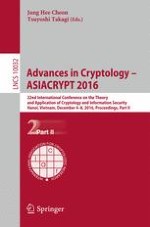2016 | OriginalPaper | Buchkapitel
Iterated Random Oracle: A Universal Approach for Finding Loss in Security Reduction
verfasst von : Fuchun Guo, Willy Susilo, Yi Mu, Rongmao Chen, Jianchang Lai, Guomin Yang
Erschienen in: Advances in Cryptology – ASIACRYPT 2016
Verlag: Springer Berlin Heidelberg
Aktivieren Sie unsere intelligente Suche, um passende Fachinhalte oder Patente zu finden.
Wählen Sie Textabschnitte aus um mit Künstlicher Intelligenz passenden Patente zu finden. powered by
Markieren Sie Textabschnitte, um KI-gestützt weitere passende Inhalte zu finden. powered by
